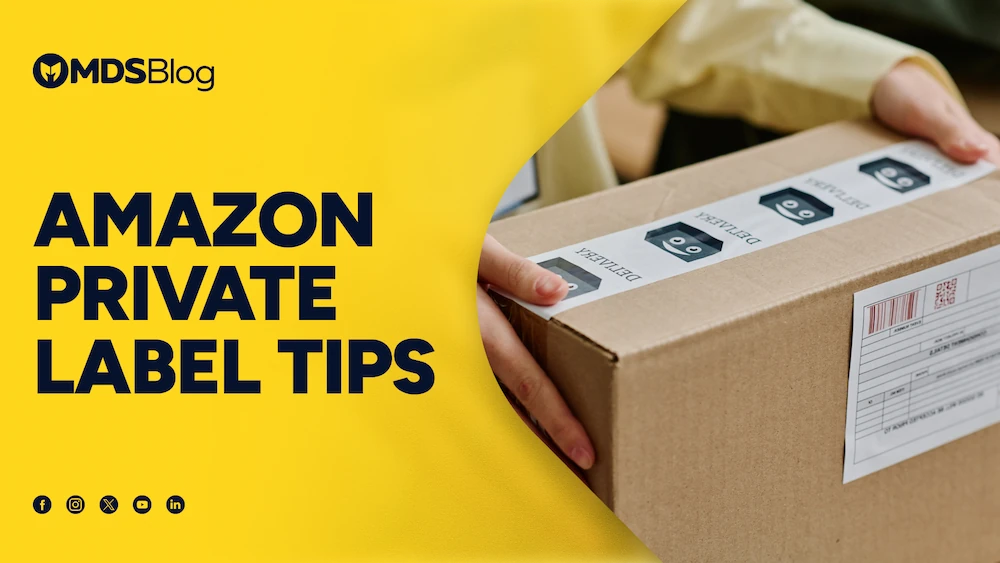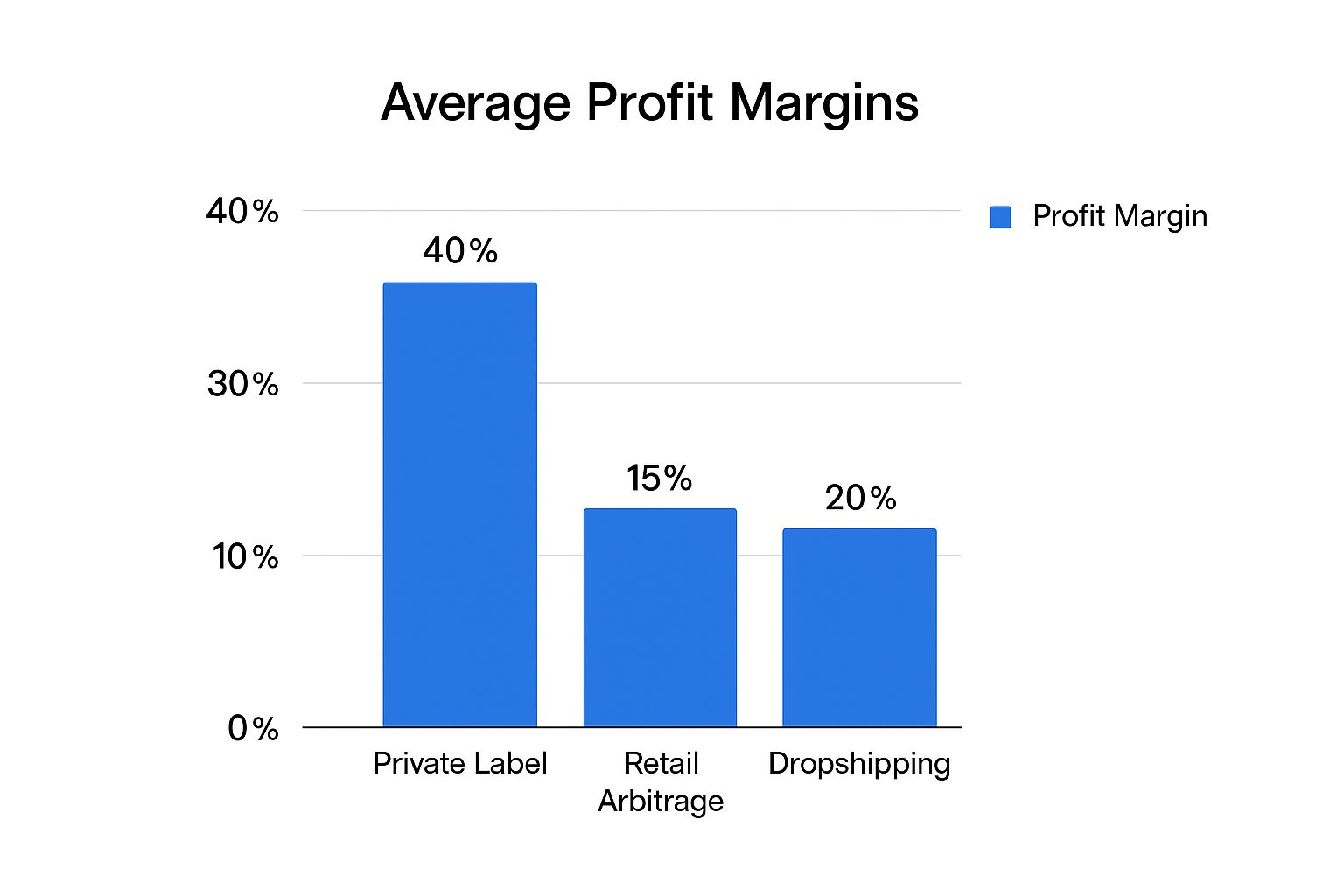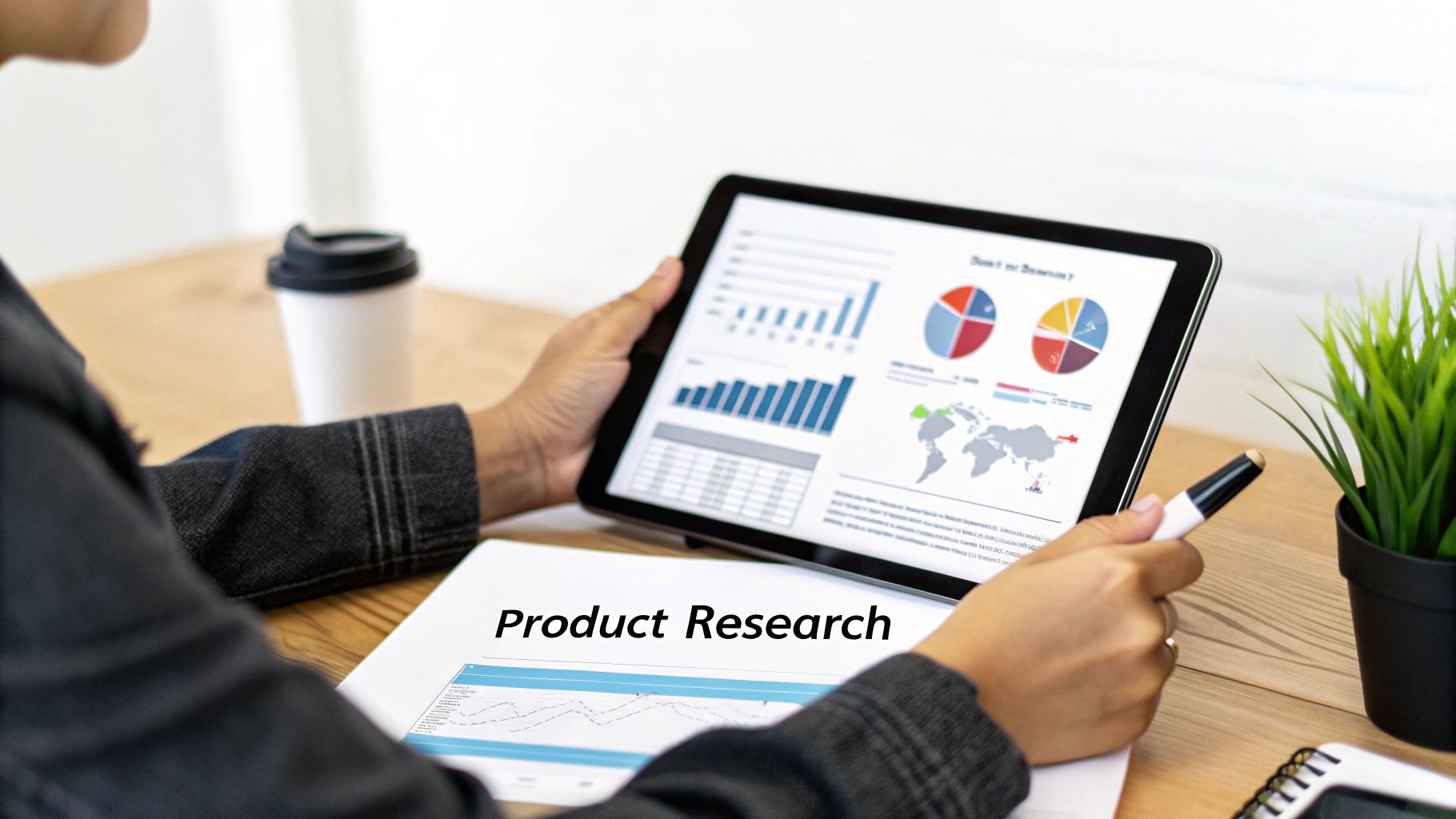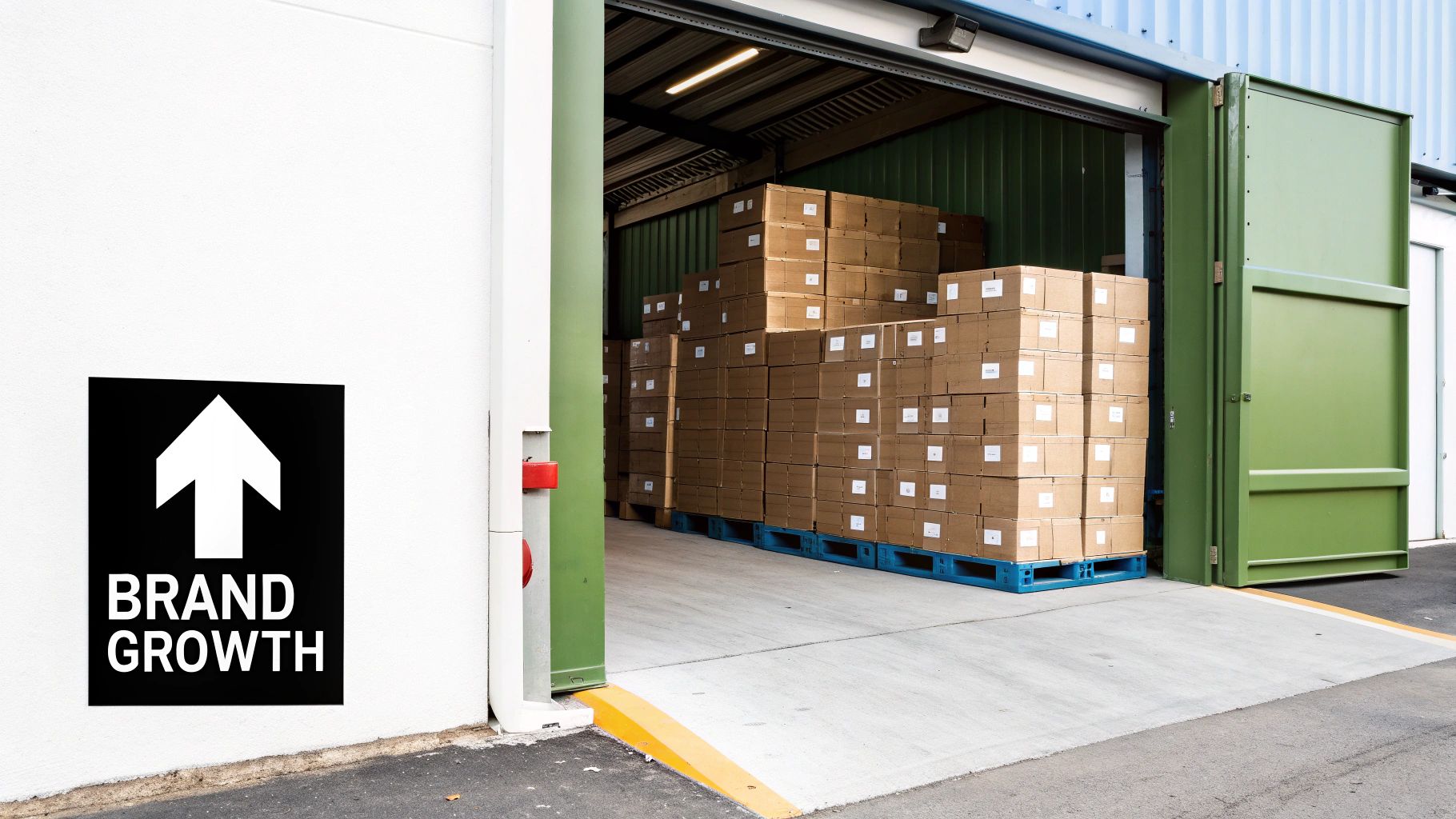Stay Updated with Everything about MDS
Thank you! Your submission has been received!
Oops! Something went wrong while submitting the form.

Chilat Doina
October 11, 2025
Ever wondered about those store-brand products at the grocery store? The coffee with the supermarket's own logo, or their version of your favorite cereal? That's a private label product. Now, imagine applying that same idea to Amazon, the biggest online marketplace on the planet.
That's exactly what an Amazon private label product is: an item made by a third-party manufacturer that you sell under your very own brand name.
Going the private label route on Amazon is how you build a real, lasting brand—not just flip someone else's stuff for a quick buck. Instead of battling dozens of other sellers on the exact same product listing (a classic headache with models like retail arbitrage), you get to create something that's uniquely yours.
The process starts with finding a product people are already searching for, usually something a bit generic. From there, you connect with a manufacturer to produce it with your own branding, custom packaging, and maybe even a few tweaks to make it better than the competition. You're in the driver's seat for the entire customer experience.
This isn't like dropshipping, where you're at the mercy of a supplier's inventory and quality control. With private label, you call the shots. It's also a world away from retail arbitrage, which is basically hunting for clearance items at Target to resell online for a small markup.
Private labeling is about building an asset.
The difference really hits home when you look at the profit potential. This chart breaks down the typical profit margins for the most common ways to sell on Amazon.

As you can see, private label products almost always deliver much healthier profit margins. That's the reward for creating and owning your own brand.
Every single sale you make does more than just put money in your pocket; it builds your brand's reputation and credibility on Amazon. Over time, that brand becomes a tangible, valuable asset. You can scale it, add more products to your lineup, or even sell the entire business down the road.
This is a strategic play focused on long-term growth, not short-term wins.
A successful private label product isn't just an item for sale; it's the foundation of a saleable business. The goal is to build equity and a loyal customer base that trusts your brand over generic alternatives.
Sure, it takes more work upfront—you have to dig into product research and find the right supplier. But the potential payoff, both in profit and in brand value, is in a different league. To get a feel for what it really takes, check out a comprehensive modern Amazon private label launch guide.

Let's be clear: creating your own Amazon private label products is a serious move. It’s the difference between renting a storefront and building your own headquarters. While other selling models get you on Amazon faster, private label is the only path to building a real, sustainable brand that you own.
The most powerful reason to go this route? The profit margins are in a completely different league. When you're just reselling someone else's stuff, you're always squeezed between their wholesale price and whatever the market will pay. The margins get razor-thin, fast.
With private label, you control the whole chain. You go straight to the factory, cutting out all the middlemen who would normally take a piece of the pie. The numbers don't lie: over 54% of private label sellers are enjoying profit margins above 20%. And once they get going, 63% of established brands pull in over $100,000 in revenue every single month. If you want a closer look, you can dig into the profit potential of private label selling.
To really grasp why this is the go-to model for serious sellers, it helps to see how it stacks up against the alternatives.
FeaturePrivate LabelRetail ArbitrageDropshippingControlComplete control over product, brand, and pricing.Zero control; you sell existing products.No control over product quality or branding.Profit MarginsHigh (often 20%+)Low (often 5-15%)Very low (often under 10%)ScalabilityHigh; build a brand with unlimited potential.Limited by what you can find and flip.Difficult; relies on others' inventory.CompetitionYou own the listing; no direct Buy Box rivals.Fierce "race to the bottom" on price.High competition on popular products.Asset ValueBuilds a valuable, sellable business asset.No long-term asset; just a cash flow model.No asset built; you're a middleman.Upfront CostHigher; involves inventory investment.Low; buy as you find deals.Very low; no inventory cost.
This table makes it pretty clear. While models like retail arbitrage and dropshipping offer a lower-cost entry point, they fundamentally limit your growth and control. Private label is where you build something with lasting value.
Beyond the money, private label puts you in the pilot's seat. Every single detail of the product and the customer's experience is yours to shape.
This is a level of command you simply can't get when you're flipping other people's products.
One of the biggest headaches for resellers is the constant battle for the "Buy Box." When dozens of sellers are all hawking the exact same item, what happens? They start undercutting each other on price until nobody is making any real money. It’s a vicious cycle.
Private label is your escape route. Since you created the brand and are the only one selling it on your unique listing, there is no competition for the Buy Box. You own your digital shelf space.
By creating a unique branded product, you effectively build a moat around your business. Customers searching for your brand will find only you, turning competition into a non-issue on your own turf.
This exclusivity is a game-changer. It means you can confidently invest in advertising and brand-building, knowing that some random seller can't just swoop in, drop their price by a penny, and steal your sale.
This might be the most overlooked—and most important—benefit of all. With private label, you're not just building an income stream. You're building a real, valuable, and sellable asset.
A successful Amazon brand has tangible worth based on its sales history, glowing reviews, supplier relationships, and customer loyalty. Every positive review you earn and every happy customer you create adds to your brand's equity.
Think long-term. When you decide to move on, you can sell your entire business to an aggregator or investor for a hefty multiple of its annual profit. This exit potential offers a level of financial security that a reselling hustle could never provide. It turns all your hard work into a true investment in your future.

Every single successful Amazon private label brand began not with a fancy logo or a brilliant marketing campaign, but with one smart product choice. This is, without a doubt, the most important decision you'll make on your entire journey.
Nail this, and you’re on the fast track to profitability. Get it wrong, and you're setting yourself up for a whole lot of frustration and wasted cash.
Think of it like prospecting for gold. You're not just grabbing any shiny rock you see. You’re systematically looking for a rich vein—a product with steady demand where you won't be elbowing a hundred other prospectors out of the way. It’s a game of finding the gaps.
The goal isn't to invent the next iPhone. Far from it. You’re looking for a product that already exists but has flaws. Something you can improve, brand beautifully, and offer to an audience that’s already searching for it.
Before you even think about opening a research tool, you need a mental checklist. A good private label candidate hits a sweet spot across a few key criteria. Trust me, ignoring these fundamentals is how most new sellers crash and burn.
A winning product almost always has:
These aren't just suggestions. They're the guardrails that will keep you from dumping your money into a product that’s too risky, too competitive, or just too expensive to get off the ground.
Gut feelings are worthless here. The modern Amazon seller plays the game with powerful research tools like Helium 10 or Jungle Scout, which basically give you x-ray vision into the entire marketplace.
These tools pull back the curtain, showing you the hard data behind any product:
This data tells a story. For instance, you might spot a product doing $30,000 in monthly revenue, but the top listings have terrible photos and an average rating of 3.5 stars. That’s a massive blinking sign that says "underserved market." It's the perfect opening for a new brand to swoop in with a better product and smarter marketing.
Want a masterclass on this? Million Dollar Sellers has a fantastic guide on how to find winning products that dives much deeper into the research process.
The most valuable skill for a private label seller isn't finding products; it's learning to read the data to spot customer pain points. A product with high demand and low review scores is a goldmine waiting to be discovered.
Okay, so you've found a promising candidate. Before you even think about wiring money to a supplier, you have to validate the idea. Don't skip this step. Seriously.
First, become obsessed with your potential competitors' customer reviews. What are people complaining about? Are the zippers on that travel bag constantly breaking? Do those silicone spatulas melt under high heat? Every single negative review is a blueprint showing you exactly how to make a better product.
Next, dig into the keyword data. Are customers using very specific phrases to find this product? High search volume for long-tail keywords (like "BPA-free silicone baking mat set") shows you there’s a specific need you can target directly in your listing and your ads.
Finally, do the math. Use a profitability calculator to map out your potential margin after you account for the cost of goods, Amazon's fees, shipping, and advertising. A product can look amazing on paper, but if the numbers don't work, it's not a business—it's a hobby.
By sticking to this data-driven framework, you stop guessing and start making calculated investments. This is how you find your first of many successful Amazon private label products.
Okay, you've pinpointed a fantastic product opportunity. Now for the exciting part: turning that idea into a real, physical item you can hold in your hands and sell.
This is where sourcing and manufacturing enter the picture. It sounds intimidating, I know. But you’re not building a factory from scratch. You're simply finding a professional partner who already has the machinery, the people, and the expertise to make your product a reality.
The main goal here is to find a reliable manufacturer who can create a top-notch product at a price that leaves you with a healthy profit margin. For most new sellers, this whole adventure starts on global sourcing platforms.
The biggest and most well-known playground for sourcing amazon private label products is Alibaba. Think of it as a gigantic, 24/7 online trade show. It connects you with thousands of manufacturers worldwide, many of whom are seasoned pros at producing goods for Western markets.
When you dive in, remember you’re not just hunting for the lowest price. You’re searching for a long-term partner. Here’s what you should be looking for when you size up potential suppliers:
Once you’ve got a shortlist of about five to ten solid-looking suppliers, it’s time to make contact. Keep your initial message professional, clear, and straight to the point. Introduce your brand, tell them exactly what product you’re interested in, and ask for their pricing, Minimum Order Quantity (MOQ), and production lead times.
I’m going to say this in big, bold, imaginary letters: Never, ever place a bulk order without getting samples first. This is the most crucial step for verifying the quality of both the product and the manufacturer. Plan on ordering samples from your top three to five candidates.
When the samples finally arrive, don't just give them a quick glance. Put them through the wringer. Use them exactly how a customer would. If it's a kitchen gadget, cook with it. If it’s a piece of luggage, pack it up and drag it around. Compare the quality of each sample side-by-side.
A product sample is so much more than a preview. It’s a direct reflection of the manufacturer's standards and their commitment to quality. A tiny flaw in a sample will almost certainly become a massive problem in a full production run.
This is also your first real test of the supplier's ability to follow directions. Did they get your requests right? Is the packaging correct? The sample phase reveals everything you need to know about who you can trust with your investment.
You've picked your winner. Now, the negotiation begins. While price is obviously important, it's not the only thing on the table. You can also negotiate the MOQ, payment terms (a 30% upfront and 70% upon completion split is pretty standard), and even custom packaging options. Building a good relationship right from the get-go can pay dividends later with better terms and service.
For a deeper dive into the art of the deal, check out our in-depth guide on negotiating with suppliers.
With the terms hammered out, you're ready to place your first official production order. It's vital to have a crystal-clear and detailed purchase order (PO). This document should outline every single product specification—from materials and colors to packaging details and labeling. Your PO is your safety net; it prevents misunderstandings and protects you if things don't go as planned.
Finally, you’ll need to get your products from the factory to Amazon. You have two main options here: air freight or sea freight. Air freight is fast (around 5-10 days) but stings the wallet. Sea freight is much, much cheaper but takes its sweet time (often 30-40 days). Most sellers use sea freight to keep their margins healthy, but air freight can be a lifesaver for quickly restocking a hot-selling item. Just be sure to factor in shipping and customs duties to calculate your "landed cost"—the true, all-in cost per unit to get your product into an Amazon warehouse.

You’ve got a high-quality product ready to go. Now what? The next step is all about making a powerful entrance into the Amazon marketplace. A product launch isn't about quietly listing your item and crossing your fingers; it's a calculated strategy to build momentum from day one.
This initial push is what signals to Amazon’s A9 algorithm that your product is relevant and deserves to be shown to more shoppers.
Your product listing is your digital storefront, your best salesperson, and your packaging all rolled into one. Every single element has to be fine-tuned to not only grab a shopper's attention but convince them to hit that "Add to Cart" button.
Think of it as making a persuasive argument. You have to present your case clearly and compellingly, leaving no room for doubt. This means nailing three core components:
A well-crafted listing is your greatest asset. It improves your visibility in search, boosts your click-through rate, and ultimately increases your conversion rate—the key to climbing the ranks on Amazon.
Once your listing is live, it’s go-time. The mission is to drive traffic and generate those crucial first sales. Early sales and reviews are powerful signals to Amazon that your product is a winner, and a targeted launch plan is how you make it happen.
A huge piece of this puzzle is Amazon's own advertising platform. Pay-Per-Click (PPC) campaigns get your product in front of active buyers from the very beginning. By bidding on relevant keywords, you can secure top spots in search results, giving your new product instant visibility. To make sure your marketing dollars are working for you, it's vital to know how to calculate marketing ROI for your campaigns.
A successful launch is a controlled burn. You strategically invest in advertising to create a concentrated burst of sales and reviews. This burst fuels the organic ranking algorithm and creates a self-sustaining sales flywheel.
This initial ad spend isn't just about sales; it's about collecting data. Your early campaigns will reveal which keywords are actually converting, giving you priceless insights to further optimize your listing and future ad efforts. For a complete playbook, check out our guide on how to launch a new product.
The launch is just the beginning. The real goal of selling Amazon private label products is to build a scalable brand, not just a one-hit-wonder. Once your first product has stable sales and positive cash flow, it's time to think bigger.
Scaling your brand typically follows a few proven paths:
This brand-building approach is how you stand out in an incredibly crowded marketplace. As of 2025, over 60% of products sold on Amazon come from third-party sellers just like you. A staggering 82% of these sellers use Fulfillment by Amazon (FBA) to handle their logistics, a massive advantage for private label businesses. By focusing on creating a real brand, you move from being just another seller to a memorable name that customers actively look for.
Alright, let's break down the jungle that is the Amazon marketplace. To really make it with a private label brand, you have to get the lay of the land.
Think of it this way: Amazon isn't just your landlord, renting you a spot on their digital shelf. They're also the mega-store right next door, and they happen to own the entire mall. They are both the platform and your biggest competitor. This dynamic changes the whole game.
You’ll see this play out most clearly with Amazon's own in-house brands, like AmazonBasics. Notice how they often snag those prime, top-of-the-page spots in search results? That’s no accident. They’re setting the bar for everything from price to shipping speed. Going head-to-head with the mall owner might sound intimidating, but it's more of a strategic puzzle than a brick wall.
So, how do you deal with Amazon breathing down your neck? Instead of seeing them as a roadblock, use them as your benchmark. Their brands usually go after the mass market with simple, no-frills products. This leaves a huge opening for sellers like you to swoop in with a brand that has a real story, better quality, and a laser-focus on a specific niche.
You’re not going to out-Amazon Amazon on price or logistics. Don't even try. But you can win by being different.
The key to thriving right alongside Amazon’s own stuff is differentiation. When you build a brand people remember, solve a problem they actually have, and deliver an experience that’s miles better, you create a loyal following that a generic giant just can’t touch.
This is where being a smaller, more nimble brand becomes your secret weapon. You can actually talk to your customers, act on their feedback instantly, and build a real community around what you sell.
Even though their own private label sales are just a sliver of the marketplace's total pie, they're playing a long game. Research has shown that by sticking their own products in top ad spots, Amazon can cool down aggressive price wars between third-party sellers. This helps them keep profit margins healthier across the board. If you're curious, you can discover more insights about Amazon's private label strategy to really get inside their thinking.
The takeaway here is that your path to success isn't a race to the bottom on price. Your strategy needs to be about building perceived value. You do that by focusing on:
Nail these areas, and you're not just surviving next to Amazon's brands—you're outmaneuvering them. You're building something they can't: a genuine connection with your customers.
Jumping into the world of Amazon private label always kicks up a ton of questions. Let's be honest, it's a big move. Getting clear, no-fluff answers is the only way you're going to feel confident enough to actually pull the trigger.
So, let's tackle some of the biggest questions I hear from new sellers all the time.
There’s no single magic number, but let's get real. You should be looking at a startup budget somewhere between $3,000 and $5,000. And no, that's not just for buying your products; that figure needs to cover everything to give you a fighting chance.
Think of it this way. Your initial investment has to stretch across:
Sure, you'll hear stories about people starting with a few hundred bucks. But a well-funded launch dramatically increases your odds of success. It means you can afford proper marketing and won't run out of stock the second you start getting sales.
Patience is the name of the game here. While a few lucky sellers might see some profit in a couple of months, a much more realistic timeline is six to twelve months. It takes time to build up a sales history, collect reviews, and really dial in your ad campaigns.
Profitability isn't a switch you flip; it's a milestone you reach. Your first few months are an investment in data collection and brand building, laying the groundwork for sustainable, long-term income.
Most of what you make in the beginning gets funneled right back into the business anyway—placing that next, bigger inventory order and maybe even scouting your second product.
Every business has its risks, and private label is definitely no exception. The number one place people trip up is product selection. If you pick something in a hyper-competitive niche or a product nobody is looking for, you can burn through your entire budget before you ever really get started.
Another huge risk is supply chain disruption. One bad manufacturing run or a major shipping delay can kill your momentum overnight. This is exactly why vetting your suppliers and always, always ordering samples is a non-negotiable step. If you can see these challenges coming, you can build a much more resilient brand from day one.
At Million Dollar Sellers, we believe in scaling smarter, not harder. Our exclusive community provides the peer support and high-level strategies you need to navigate these challenges and accelerate your growth. Join the top e-commerce entrepreneurs and stay ahead of the curve. Discover Million Dollar Sellers.
Join the Ecom Entrepreneur Community for Vetted 7-9 Figure Ecommerce Founders
Learn MoreYou may also like:
Learn more about our special events!
Check Events